曼昆经济学原理Chapter 10
- 格式:ppt
- 大小:1.32 MB
- 文档页数:19

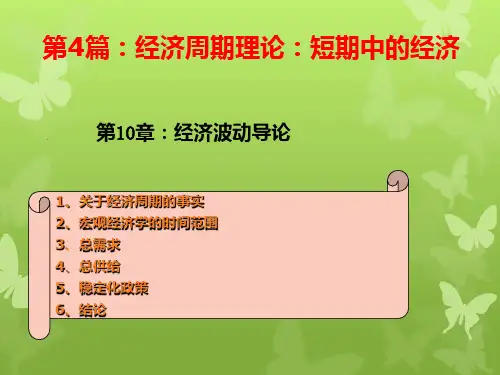
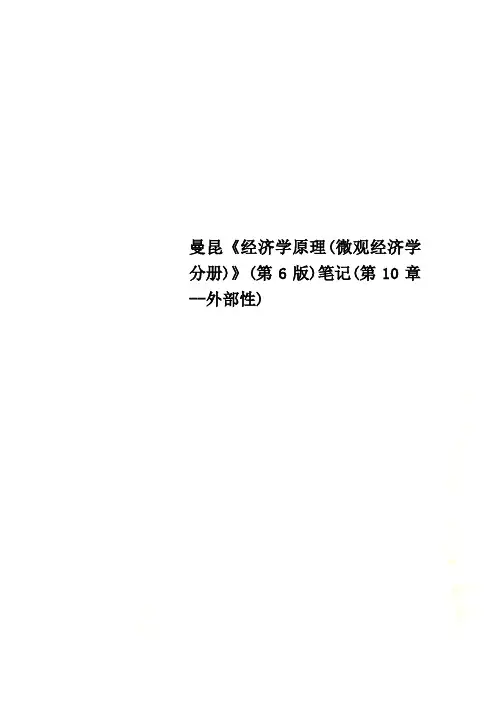
曼昆《经济学原理(微观经济学分册)》(第6版)笔记(第10章--外部性)曼昆《经济学原理(微观经济学分册)》(第6版)第10章外部性复习笔记跨考网独家整理最全经济学考研真题,经济学考研课后习题解析资料库,您可以在这里查阅历年经济学考研真题,经济学考研课后习题,经济学考研参考书等内容,更有跨考考研历年辅导的经济学学哥学姐的经济学考研经验,从前辈中获得的经验对初学者来说是宝贵的财富,这或许能帮你少走弯路,躲开一些陷阱。
以下内容为跨考网独家整理,如您还需更多考研资料,可选择经济学一对一在线咨询进行咨询。
一、外部性和市场无效率外部性(externality):一个人的行为对旁观者福利的无补偿的影响。
如果对旁观者的影响是不利的,就称为负外部性;如果这种影响是有利的,就称为正外部性。
在存在外部性时,市场均衡并不是有效的,均衡并没有实现整个社会总利益的最大化。
1.福利经济学:回顾图10-1表示铝市场的供给曲线与需求曲线。
需求曲线的高度表示边际买者的支付意愿,也就是购买最后一单位铝对消费者的价值。
供给曲线的高度表示边际卖者的成本,也就是出售最后一单位铝对生产者的成本。
在没有政府干预时,铝的价格会自发调整,所示的市使铝的供求达到平衡。
如图10-1的Q市场场均衡时的生产量和消费量,在使生产者剩余和消费者剩余之和最大化的意义上说是有效率的。
图10-1 铝市场2.负的外部性假设铝工厂排放污染物,产生负的外部性,使得生产铝的社会成本大于铝的私人成本。
因此社会成本曲线在供给曲线之上。
一个仁慈的社会计划者会力图使该市场产生的总剩余——铝对消费者的价值减去生产铝的社会成本——最大化。
决定了社会的最适量(即Q最适),如果不考虑对除生产者之外的其他人的影响,则均衡数量为Q市场。
此时铝的均衡数量(即Q市场)大于社会的最适量(即Q最适)。
出现这种无效率是因为市场均衡仅仅反映了生产的私人成本。
在市场均衡时,边际消费者对铝的评价小于生产它的社会成本。


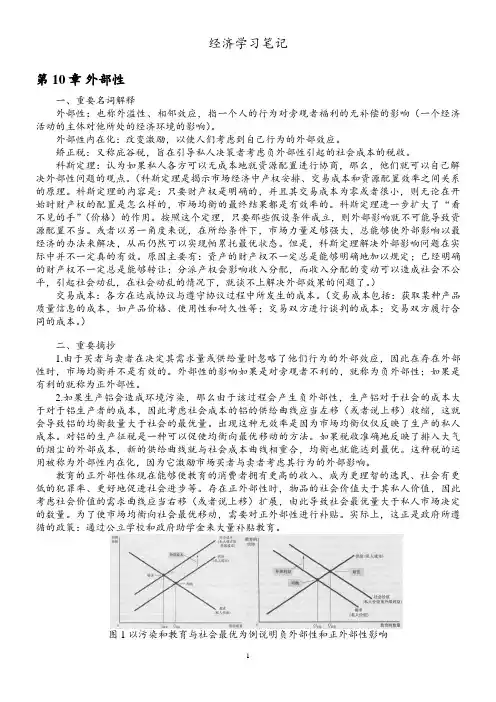
经济学习笔记第10章外部性一、重要名词解释外部性:也称外溢性、相邻效应,指一个人的行为对旁观者福利的无补偿的影响(一个经济活动的主体对他所处的经济环境的影响)。
外部性内在化:改变激励,以使人们考虑到自己行为的外部效应。
矫正税:又称庇谷税,旨在引导私人决策者考虑负外部性引起的社会成本的税收。
科斯定理:认为如果私人各方可以无成本地就资源配置进行协商,那么,他们就可以自己解决外部性问题的观点。
(科斯定理是揭示市场经济中产权安排、交易成本和资源配置效率之间关系的原理。
科斯定理的内容是:只要财产权是明确的,并且其交易成本为零或者很小,则无论在开始时财产权的配置是怎么样的,市场均衡的最终结果都是有效率的。
科斯定理进一步扩大了“看不见的手”(价格)的作用。
按照这个定理,只要那些假设条件成立,则外部影响就不可能导致资源配置不当。
或者以另一角度来说,在所给条件下,市场力量足够强大,总能够使外部影响以最经济的办法来解决,从而仍然可以实现帕累托最优状态。
但是,科斯定理解决外部影响问题在实际中并不一定真的有效。
原因主要有:资产的财产权不一定总是能够明确地加以规定;已经明确的财产权不一定总是能够转让;分派产权会影响收入分配,而收入分配的变动可以造成社会不公平,引起社会动乱,在社会动乱的情况下,就谈不上解决外部效果的问题了。
)交易成本:各方在达成协议与遵守协议过程中所发生的成本。
(交易成本包括:获取某种产品质量信息的成本,如产品价格、使用性和耐久性等;交易双方进行谈判的成本;交易双方履行合同的成本。
)二、重要摘抄1.由于买者与卖者在决定其需求量或供给量时忽略了他们行为的外部效应,因此在存在外部性时,市场均衡并不是有效的。
外部性的影响如果是对旁观者不利的,就称为负外部性;如果是有利的就称为正外部性。
2.如果生产铝会造成环境污染,那么由于该过程会产生负外部性,生产铝对于社会的成本大于对于铝生产者的成本,因此考虑社会成本的铝的供给曲线应当左移(或者说上移)收缩,这就会导致铝的均衡数量大于社会的最优量。
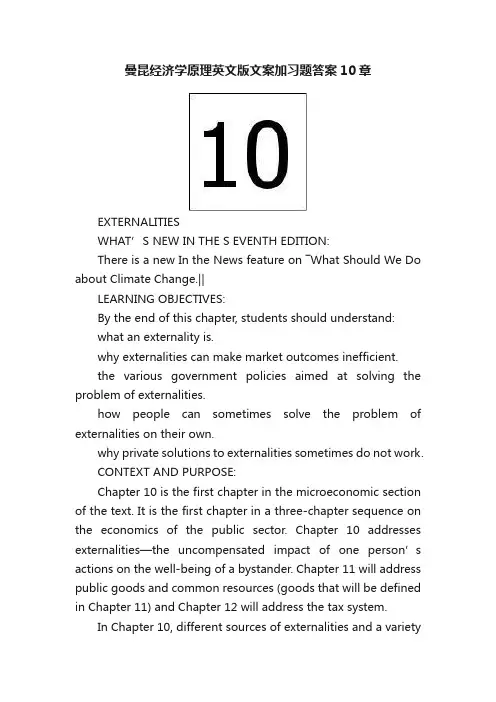
曼昆经济学原理英文版文案加习题答案10章EXTERNALITIESWHAT’S NEW IN THE S EVENTH EDITION:There is a new In the News feature on ―What Should We Do about Climate Change.‖LEARNING OBJECTIVES:By the end of this chapter, students should understand:what an externality is.why externalities can make market outcomes inefficient.the various government policies aimed at solving the problem of externalities.how people can sometimes solve the problem of externalities on their own.why private solutions to externalities sometimes do not work.CONTEXT AND PURPOSE:Chapter 10 is the first chapter in the microeconomic section of the text. It is the first chapter in a three-chapter sequence on the economics of the public sector. Chapter 10 addresses externalities—the uncompensated impact of one person’s actions on the well-being of a bystander. Chapter 11 will address public goods and common resources (goods that will be defined in Chapter 11) and Chapter 12 will address the tax system.In Chapter 10, different sources of externalities and a varietyof potential cures for externalities are addressed. Markets maximize total surplus to buyers and sellers in a market. However, if a market generates an externality (a cost or benefit to someone external to the market) the market equilibrium may not maximize the total benefit to society. Thus, in Chapter 10 we will see that while markets are usually a good way to organize economic activity, governments can sometimes improve market outcomes.182Chapter 10/Externalities ? 183KEY POINTS:When a transaction between a buyer and seller directly affects a third party, the effect is called an externality. If an activity yields negative externalities, such as pollution, the socially optimal quantity in a market is less than the equilibrium quantity. If an activity yields positive externalities, such as technology spillovers, the socially optimal quantity is greater than the equilibrium quantity.Governments pursue various policies to remedy the inefficiencies caused by externalities. Sometimes the government prevents socially inefficient activity by regulating behavior. Other times it internalizes an externality using corrective taxes. Another public policy is to issue permits. For example, the government could protect the environment by issuing a limited number of pollution permits. The result of this policy is largely the same as imposing corrective taxes on polluters.Those affected by externalities can sometimes solve the problem privately. For instance, when one business imposes anexternality on another business, the two businesses can internalize theexternality by merging. Alternatively, the interested parties can solve the problem by negotiating a contract. According to the Coase theorem, if people can bargain without cost, then they can always reach an agreement in which resources are allocated efficiently. In many cases, however, reaching a bargain among the many interested parties is difficult, so the Coase theorem does not apply.CHAPTER OUTLINE:I. Definition of externality : the uncompensated impact of one person’s actions on the well -being of a bystander.A. If the impact on the bystander is adverse, we say that there is a negative externality.B. If the impact on the bystander is beneficial, we say that there is a positive externality.C. In either situation, decisionmakers fail to take account of the external effects of their behavior.II. Externalities and Market InefficiencyA. Welfare Economics: A Recap1. The demand curve for a good reflects the value of that good to consumers, measured by theprice that the marginal buyer is willing to pay.2. The supply curve for a good reflects the cost of producing that good.3. In a free market, the price of a good brings supply and demand into balance in a way thatmaximizes total surplus (the difference between theconsumers’ valuation of the good and the sellers’ cost of producing it).184 ? Chapter 10/ExternalitiesB. Negative Externalities1. Example: An aluminum firm emits pollution during production.2. Social cost is equal to the private cost to the firm of producing the aluminum plus theexternal costs to those bystanders affected by the pollution. Thus, social cost exceeds the private cost paid by producers.3. The optimal amount of aluminum in the market will occur where total surplus is maximized.a. Total surplus is equal to the value of aluminum to consumers minus the cost (social cost)of producing it.b. This will occur where the social-cost curve intersects with demand curve. At this point,producing one more unit would lower total surplus because the value to consumers is less than the cost to produce it.4. Because the supply curve does not reflect the true cost of producing aluminum, the marketwill produce more aluminum than is optimal. 5. This negative externality could be internalized by a tax on producers for each unit ofaluminum sold.ALTERNATIVE CLASSROOM EXAMPLE:A coal-fired power plant emits pollution during production.Chapter 10/Externalities ? 1856. Definition of internalizing an externality: altering incentives so that people takeaccount of the external effects of their actions.7. In the News: The Externalities of Country Livinga. In The Lorax by Dr. Seuss, urbanization is criticized while country living is consideredmore environmentally friendly.b. This article from The New York Times describes research that suggests that city livingmay in fact be ―green er‖ because of the use of public transportation.C. Positive Externalities1. Example: education.2. Education yields positive externalities because better-educated voters lead to a bettergovernment. Crime rates also drop as the education level of the population rises.3. In this case, the demand curve does not reflect the social value of a good.4. If there is a positive externality, the social value of the good is greater than the private value,and the optimum quantity will be greater than the quantity produced in the market.5. To internalize a positive externality, the government could use a subsidy.Figure 3ALTERNATIVE CLASSROOM EXAMPLE:The purchase of a fire extinguisher when an individual lives in an apartment complex This is a good time to discuss why the government taxes goods like alcohol, tobacco, and gasoline. You will find that students have heard the phrase ―sin tax,‖ but they often do not understand why economists might support such taxes (given thedeadweight loss from taxes discussed in Chapter 8).186 ?Chapter 10/Externalities6. Case Study: Technology Spillovers, Industrial Policy, and Patent Protectiona. A technology spillover occurs when one firm’s research and production efforts impactanother firm’s access to technological advance.b. It is difficult to measure the amounts of technology spillover that occur and this leads toa debate over whether or not the government should pursue policies to encourage theproduction of technology.c. Patent protection is a type of technology policy of the government because it protectsthe rights of inventors who create new technologies. Without patents, there would beless incentive to develop new ideas and technologies.III. Public Policies toward ExternalitiesA. When an externality causes a market to reach an inefficient allocation of resources, thegovernment can respond in two ways.1. Command-and-control policies regulate behavior directly.2. Market-based policies provide incentives so that private decisionmakers will choose to solvethe problem on their own.B. Command-and-Control Policies: Regulation1. Externalities can be corrected by requiring or forbidding certain behaviors.2. In the United States, the Environmental Protection Agency (EPA) develops and enforcesregulations aimed at protecting the environment.3. EPA regulations include maximum levels of pollution allowed or required adoption of aparticular technology to reduce emissions.C. Market-Based Policy 1: Corrective Taxes and Subsidies1. Externalities can be internalized through the use of taxes and subsidies.2. Definition of corrective tax: a tax designed to induce private decisionmakers to takeaccount of the social costs that arise from a negative externality.a. These taxes are preferred by economists over regulation, because firms that can reducepollution with the least cost are likely to do so (to avoid the tax) while firms thatencounter high costs when reducing pollution will simply pay the tax.b. Thus, this tax allows firms that face the highest cost of reducing pollution to continue topollute while encouraging less pollution over all.Chapter 10/Externalities ?187c. Unlike other taxes, corrective taxes do not cause a reduction in total surplus. In fact,they increase economic well-being by forcing decisionmakers to take into account thecost of all of the resources being used when making decisions.3. Case Study: Why Is Gasoline Taxed So Heavily?a. In the United States, almost half of what drivers pay for gasoline goes to gas taxes.b. This is to correct for three negative externalities associated with driving: congestion,accidents, and pollution.D. Market-Based Policy 2: Tradable Pollution Permits1. Example: EPA regulations restrict the amount of pollution that two firms can emit at 300 tonsof glop per year. Firm A wants to increase its amount of pollution. Firm B agrees to decrease its pollution by the same amount if Firm A pays it $5 million.2. Social welfare is increased if the EPA allows this situation. Total pollution remains the sameso there are no external effects. If both firms are doing this willingly, it must make thembetter off.3. If the EPA issued permits to pollute and then allowed firms to sell them, this would alsoincrease social welfare. Firms that could control pollution most inexpensively would do so and sell their permits, while those who encounter high costs when reducing pollution would buyadditional permits.4. Tradable pollution permits and corrective taxes are similar in effect. In both cases, firms mustpay for the right to pollute.a. In the case of the tax, the government basically sets the price of pollution and firms thenchoose the level of pollution (given the tax) that maximizes their profit.b. If tradable pollution permits are used, the government chooses the level of pollution (intotal, for all firms) and firms then decide what they are willing to pay for these permits.188 ?Chapter 10/ExternalitiesE. Objections to the Economic Analysis of Pollution1. Some individuals dislike the idea of allowing companies to purchase the right to pollute.2. Economists point out that ―people face trade-offs‖ (Principle #1) and we must decide howmuch we would be willing to give up in exchange for no pollution. It would likely not beenough.3. A clean environment can be viewed as any other good that obeys the law of demand. Thelower the price of environmental protection, the more the public will want.F. In the News: What Should We Do about Climate Change?1. Many policy analysts believe that taxing carbon is the best approach to dealing with globalclimate change..2. This article from The New York Times explains how the revenue-neutral carbon tax works inBritish Columbia and argues for its implementation in the United States..IV. Private Solutions to ExternalitiesA. We do not necessarily need government involvement to correct externalities.B. The Types of Private Solutions1. Problems of externalities can sometimes be solved by moral codes and social sanctions.a. Do not litter.b. The Golden Rule2. Many charities have been established that deal with externalities. The governmentencourages this private solution by allowing a deduction for charitable contributions in thedetermination of taxable income.a. Sierra Club (environment)b. University Alumni Association (scholarships)3. The parties involved in this externality (either the seller and the bystander or the consumerand the bystander) can possibly enter into an agreement to correct the externality.C. The Coase Theorem1. Definition of Coase theorem: the proposition that if private parties can bargainwithout cost over the allocation of resources, they can solve the problem ofexternalities on their own.Chapter 10/Externalities ?1892. Example: Dick owns a dog Spot who disturbs a neighbor (Jane) with its barking.a. One possible solution to this problem would be for Jane to pay Dick to get rid of the dog.The amount that she would be willing to pay would be equal to her valuation of the costsof the barking. Dick would only agree to this if Jane paid him an amount greater than thevalue he places on owning Spot.b. Even if Jane could legally force Dick to get rid of Spot, another solution could occur. Dickcould pay Jane to let him keep the dog.3. Whatever the initial distribution of rights, the parties involved in an externality can potentiallysolve the problem themselves and reach an efficient outcome where both parties are betteroff.D. Why Private Solutions Do Not Always Work1. Definition of transaction costs: the costs that parties incur in the process ofagreeing and following through on a bargain.2. Coordination of all of the interested parties may be difficult so that bargaining breaks down.This is especially true when the number of interested parties is large. SOLUTIONS TO TEXT PROBLEMS:Quick Quizzes1. Examples of negative externalities include pollution, barking dogs, and consumption ofalcoholic beverages. Examples of positive externalitiesinclude the restoration of historicbuildings, research into new technologies, and education. (Many other examples of negativeand positive externalities are possible.) Market outcomes are inefficient in the presence ofexternalities because markets produce a larger quantity than is socially desirable when thereis a negative externality and a smaller quantity than is socially desirable when there is apositive externality. The market outcomes do not account for all of the costs (negativeexternalities) or benefits (positive externalities) to society.2. The town government might respond to the externality from the smoke in three ways: (1)regulation; (2) corrective taxes; or (3) tradable pollution permits.Regulation prohibiting pollution beyond some level is good because it is often effective atreducing pollution. But doing so successfully requires the government to have a lot ofinformation about the industries and the alternative technologies that those industries couldadopt.Corrective taxes are a useful way to reduce pollution because the tax can be increased to getpollution to a lower level and because the taxes raise revenue for the government. The tax ismore efficient than regulation because it gives factories economic incentives to reducepollution and to adopt new technologies that pollute less.The disadvantage of correctivetaxes is that the government needs to know a lot of information to pick the right tax rate.Tradable pollution permits are similar to corrective taxes but allow the firms to trade the rightto pollute with each other. As a result, the government does not need as much informationabout the firms’ technologies. The government c an simply set a limit on the total amo unt of190 ?Chapter 10/Externalitiespollution, issue permits for that amount, and allow the firms to trade the permits. Thisreduces pollution while allowing economic efficiency.3. Examples of private solutions to externalities include moral codes and social sanctions,charities, and relying on the interested parties entering into contracts with one other.The Coase theorem is the proposition that if private parties can bargain without cost over theallocation of resources, they can solve the problem of externalities on their own.Private economic participants are sometimes unable to solve the problems caused by anexternality because of transaction costs or because bargaining breaks down. This is mostlikely when the number of interested parties is large.Questions for Review1. Examples of negative externalities include pollution, barking dogs, and consumption ofalcoholic beverages. Examples of positive externalitiesinclude the restoration of historicbuildings, research into new technologies, and education. (Many other examples of negativeand positive externalities are possible.)2. Figure 1 illustrates the effect of a negative externality. The equilibrium quantity provided bythe market is Q market. Because of the externality, the social cost of production is greater thanthe private cost of production, so the social-cost curve is above the supply curve. The optimalquantity for society is Q optimum. The private market produces too much of the good becauseQ market is greater than Q optimum.Figure 13. The patent system helps society solve the externality problem from technology spillovers. Bygiving inventors exclusive use of their inventions for a certain period, the inventor cancapture much of the economic benefit of the invention. In doing so, the patent systemencourages research and technological advance, which benefits society through spillovereffects.Chapter 10/Externalities ?1914. Corrective taxes are taxes enacted to correct the effects ofa negative externality. Economistsprefer corrective taxes over regulations as a way to protect the environment from pollutionbecause they can reduce pollution at a lower cost to society.A tax can be set to reducepollution to the same level as a regulation. The tax has the advantage of letting the marketdetermine the least expensive way to reduce pollution. The tax gives firms incentives todevelop cleaner technologies to reduce the taxes they have to pay.5. Externalities can be solved without government intervention through moral codes and socialsanctions, charities, merging firms whose externalities affect each other, or by contract.6. According to the Coase theorem, you and your roommate will bargain over whether yourroommate will smoke in the room. If you value clean air morethan your roommate valuessmoking, the bargaining process will lead to your roommate not smoking. But if yourroommate values smoking more than you value clean air, the bargaining process will lead toyour roommate smoking. The outcome is efficient as long as transaction costs do not preventan agreement from taking place. The solution may be reached by one of you paying off theother either not to smoke or for the right to smoke.Quick Check Multiple Choice1. c2. b3. a4. c5. b6. cProblems and Applications1. The Club conveys a negative externality on other car owners because car thieves will notattempt to steal a car with The Club visibly in place. This means that they will move on toanother car. The Lojack system conveys a positive externality because thieves do not knowwhich cars have this technology. Therefore, they are less likely to steal any car. Policyimplications include a subsidy for car owners that use the Lojack technology or a tax onthose who use The Club.2. a. Fire extinguishers exhibit positive externalities becauseeven though people buy them fortheir own use, they may prevent fire from damaging the property of others.192 ? Chapter 10/ExternalitiesFigure 2b. Figure 2 illustrates the positive externality from fire extinguishers. Notice that the social-value curve is above the demand curve and the social-cost curve is the same as the supply curve.c. The market equilibrium level of output is denoted Q market and the efficient level of outputis denoted Q optimum . The quantities differ because in deciding to buy fire extinguishers, people don't account for the benefits they provide to others.d. A government policy that would result in the efficient outcome would be to subsidizepeople $10 for every fire extinguisher they buy. This would shift the demand curve up to the social-value curve, and the market quantity would increase to the optimum quantity. 3. a. The extra traffic is a negative externality because the social cost is greater than theprivate cost..b. Figure 3 shows the market for theater tickets. Because there is no external benefit, thesocial-value curve is the same as the demand curve in this case. However, the social-cost curve lies $5 above the supply curve at each quantity. The efficient level of output occurs where the social-value curve (which is demand in this case) and the social-cost curve intersect..Figure 3optimum market Price of TicketsChapter 10/Externalities ?193c. This is a positive externality because the social value of theater tickets is greater than theprivate value in this case.d. Figure 4 shows both the positive and the negative externalities.Figure 4e. A tax of $3 per ticket will lead to the efficient outcome. The market equilibrium quantitywill be equal to the social optimum.4. a. The market for alcohol is shown in Figure5. The social-value curve is the same as thedemand curve in this case. The social-cost curve is above the supply curve because ofthe negative externality from increased motor vehicle accidents caused by those whodrink and drive. The market equilibrium level of output is Q market and the efficient level of output is Q optimum.b. The triangular area between points A, B, and C represents the deadweight loss of themarket equilibrium. This area shows the amount by which social costs exceed socialvalue for the quantity of alcohol consumption beyond the efficient level.Figure 5194 ?Chapter 10/Externalities5. a. It is efficient to have different amounts of pollution reduction at different firms becausethe costs of reducing pollution differ across firms. If all firms were made to reducepollution by the same amount, the costs would be low at some firms and prohibitivelyhigh at others, imposing a greater burden overall.b. Command-and-control approaches that rely on uniformpollution reduction among firmsgive the firms no incentive to reduce pollution beyond the mandated amount. Instead,every firm will reduce pollution by just the amount required and no more.c. Corrective taxes or tradable pollution rights give firms greater incentives to reducepollution. Firms are rewarded by paying lower taxes or spending less on permits if theyfind methods to reduce pollution, so they have the incentive to engage in research onpollution control. The government does not have to figure out which firms can reducepollution the most?it lets the market give firms the incentive to reduce pollution on theirown.6. a. A t a price of $1.50, each Whovillian will consume 4 bottles of Zlurp. Eac h consumer’stotal willingness to pay is $14 (= $5 + $4 + $3 + $2). The total spent by each Whovillianon Zlurp is $6 (= $1.50 ? 4). Therefore, each consumer receives $8 in consumer surplus(=$14 ? $6).b. Total surplus would fall by $4 to $4.c. If Cindy Lou only consumes 3 bottles of Zlurp, her consumer surplus is $4.50. Herwillingness to pay for 3 bottles is $5 + $4 + $3 = $12. She pays $1.50 x 3 = $4.50 andthe externality is $1 x 3 = $3. Thus, Cindy Lou's consumer surplus is $12 - $4.50 - $3.00= $4.50. Cindy’s decision increases consumer surplus in Whoville by $0.50 ($4.50-$4.00).d. The $1 tax raises the price of a bottle of Zlurp to $2.50. (The entire tax will be borne byconsumers because supply is perfectly elastic.) Each resident will purchase only 3 bottlesat the higher price and each consumer’s total willingness to pay is now $12 (= $5 + $4 +$3). Each resident pays $7.50 (= $2.50 ? 3). Therefore, each resident receives $4.50($12-$7.50) in consumer surplus.Because each bottle has an external cost of $1, the per-resident external cost is $3 ($1per bottle x 3 bottles). The government collects $3 per resident in revenue. Total surpluswith the tax is equal to $4.50 - $3.00 + $3.00 = $4.50.e. Yes, because total surplus is now higher than before the tax.7. a. The externality is noise pollution. Ringo’s consumption of rock and roll music affectsLuciano, but Ringo does not consider that in deciding how loudly he plays his music.b. The landlord could impose a rule that music could not be played above a certain decibellevel. This could be inefficient because there would be no harm done by Ringo playinghis music loud if Luciano is not home.c. Ringo and Luciano could negotiate an agreement that might, for example, allow Ringo toplay his music loudly at certain times of the day. They mightnot be able to reach anagreement if the transaction costs are high or if bargaining fails because each holds outfor a better deal.Chapter 10/Externalities ?195 8. a. An improvement in the technology for controlling pollution would reduce the demand forpollution rights, shifting the demand curve to the left. Figure 6 illustrates what wouldhappen if there were a corrective tax, while Figure 7 shows the impact if there were afixed supply of pollution permits. In both figures, the curve labeled D1 is the originaldemand for pollution rights and the curve labeled D2 is the new demand for pollutionrights after the improvement in technology.Figure 6b. With a corrective tax, the price of pollution remains unchanged and the quantity ofpollution declines, as Figure 6 shows. With pollution permits, the price of pollutiondeclines and the quantity of pollution is unchanged, as Figure 7 illustrates.Figure 79. a. In terms of economic efficiency in the market for pollution, it does not matter if thegovernment distributes the permits or auctions them off, as long as firms can sell thepermits to each other. The only difference would be that the government could makemoney if it auctioned the permits off, thus allowing it to reduce taxes, which would help196 ?Chapter 10/Externalitiesreduce the deadweight loss from taxation. There could also be some deadweight lossoccurring if firms use resources to lobby for additional permits.b. If the government allocated the permits to firms who did not value them as highly asother firms, the firms could sell the permits to each other so they would end up in thehands of the firms who value them most highly. Thus, the allocation of permits amongfirms would not matter for efficiency. But it would affect the distribution of wealth,because those who got the permits and sold them would be better off.10. a. The firms with the highest cost of reducing pollution will buy permits rather than reducetheir pollution. Firms that can sell their permits for more than it costs them to reducetheir pollution will sell.Because firm B faces the highest costs of reducing pollution, $25 per unit, it will keep itsown 40 permits and buy 40 permits from the other firms, so that it can still pollute 80units. Thus, firm B does not reduce its pollution at all.Of the two remaining firms, firm A has the higher cost of reducing pollution so it willkeep its own 40 permits and reduce its pollution by 30 units at a cost of $20 x 30 units =$600.Firm C sells all 40 of its permits to firm B and reduces its pollution by 50 units at a cost of$10 × 50 = $500. The total cost of pollution reduction is。



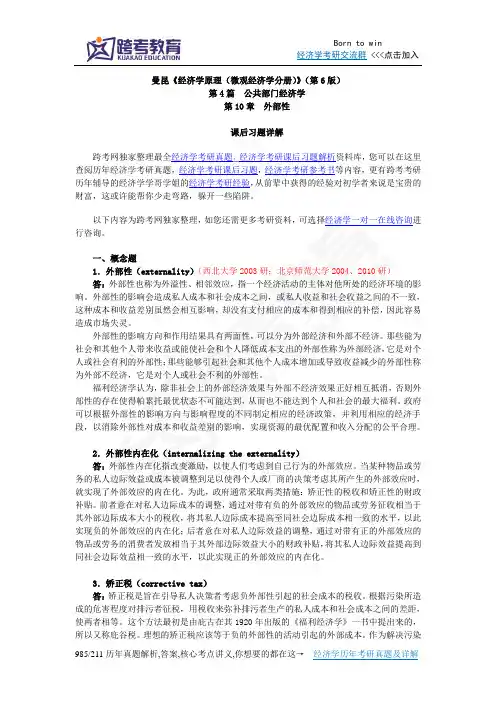
曼昆《经济学原理(微观经济学分册)》(第6版)第4篇公共部门经济学第10章外部性课后习题详解跨考网独家整理最全经济学考研真题,经济学考研课后习题解析资料库,您可以在这里查阅历年经济学考研真题,经济学考研课后习题,经济学考研参考书等内容,更有跨考考研历年辅导的经济学学哥学姐的经济学考研经验,从前辈中获得的经验对初学者来说是宝贵的财富,这或许能帮你少走弯路,躲开一些陷阱。
以下内容为跨考网独家整理,如您还需更多考研资料,可选择经济学一对一在线咨询进行咨询。
一、概念题1.外部性(externality)(西北大学2003研;北京师范大学2004、2010研)答:外部性也称为外溢性、相邻效应,指一个经济活动的主体对他所处的经济环境的影响。
外部性的影响会造成私人成本和社会成本之间,或私人收益和社会收益之间的不一致,这种成本和收益差别虽然会相互影响,却没有支付相应的成本和得到相应的补偿,因此容易造成市场失灵。
外部性的影响方向和作用结果具有两面性,可以分为外部经济和外部不经济。
那些能为社会和其他个人带来收益或能使社会和个人降低成本支出的外部性称为外部经济,它是对个人或社会有利的外部性;那些能够引起社会和其他个人成本增加或导致收益减少的外部性称为外部不经济,它是对个人或社会不利的外部性。
福利经济学认为,除非社会上的外部经济效果与外部不经济效果正好相互抵消,否则外部性的存在使得帕累托最优状态不可能达到,从而也不能达到个人和社会的最大福利。
政府可以根据外部性的影响方向与影响程度的不同制定相应的经济政策,并利用相应的经济手段,以消除外部性对成本和收益差别的影响,实现资源的最优配置和收入分配的公平合理。
2.外部性内在化(internalizing the externality)答:外部性内在化指改变激励,以使人们考虑到自己行为的外部效应。
当某种物品或劳务的私人边际效益或成本被调整到足以使得个人或厂商的决策考虑其所产生的外部效应时,就实现了外部效应的内在化。
第4部分公共部门经济学第10章外部性①积极外部性与消极外部性外部性(externality):内部的行为影响到旁观者的福利,但未付出或接受补偿,有利的为积极外部性(positive),如新技术,修复古建筑,有害的则为消极外部性(negative),如尾气具有消极外部性的产业,其社会成本大于个人成本,即社会成本曲线在供应曲线之上,社会最佳点(optimum)比均衡点价格高,数量小增加对生产者的赋税可以使均衡点更接近最佳点外部性的内在化(internalizing the externality):使内部参与者考虑其行为的外部性具有积极外部性的产业,其社会价值高于个人价值,即社会价值曲线在需求曲线之上,社会最佳点的价格数量都比均衡点高补贴具有外部性的产业可以使均衡点更接近最佳点例1:技术外溢(technology spillover)具有积极外部性,政府常补贴厂家或通过专利法来保护其利益②解决外部性的方法个人的解决方法:1.通过道德规范和社会约束,如禁止乱扔垃圾2.慈善机构3.使不同产业合作,如果树种植和蜜蜂养殖4.签订合同科斯定理(Coase theorem):如果当事人能不以资源分配为代价协商,他们能自己解决外部性的问题,不管原始状态如何,他们能产生一个有效率的结果由于交易成本的存在,或各方都想要更好的结果,或当事方太多,私下解决有时难以实现交易成本(transaction cost):当事人产生并执行协定过程中产生的成本政府的解决方法:1.命令与控制政策(command-and-control policy):禁止或要求某些行为,如环保控制2.立足于市场的政策(market-based policy):1)征收惩治性赋税(corrective tax)或补贴惩治性赋税:为应对外部性而设的税,又叫庇古税(Pigovian tax),它不同于其他税,不仅为政府筹得了收益,也提高了经济效率例1:对汽油征税,能减少堵塞、交通事故和环境污染2)可交易的排污许可,规定了排污总量。
曼昆经济学原理10外部性在本章中你将——了解什么是外部性明白什么缘故外部性会使市场结果无效率考察有时人们如何能够自己解决外部性问题专虑什么缘故私人解决外部性的方法有时不起作用考察旨在解决外部性问题的各种政府政策生产并销售纸张的企业产生了作为制造过程的副产品,即称为迪欧森〔dioxin〕的化学物质。
科学家相信,一旦迪欧森进入环境,就增加了人们患癌症的危险,生出畸形儿,并引起其他健康问题。
生产并排放迪欧森对社会是不是一个问题呢?在第四章到第九章中,我们考虑了市场如何用供求的力量配置稀缺资源,并说明了供求均衡一样是一种有效率的资源配置。
用亚当·斯密闻名的比喻,确实是市场中〝看不见的手〞引导市场上利己的买者和卖者,使从那种市场上产生的社会总收益最大化。
这种见解是第一章中的经济学十大原理之一的基础:市场通常是一种组织经济活动的好方法;。
我们是否能够由此得出结论认为,看不见的手能够阻止造纸市场的企业不排放过多迪欧森呢?市场做了许多好事,但并不能做好每一件事。
在本章中我们开始研究经济学十大原理的另一个原理:政府有时能够改善市场结果。
我们考察什么缘故市场有时不能有效地配置资源,政府政策如何能够潜在地改善市场配置,以及哪种政策能够最好地发挥作用。
本章中所考察的市场失灵属于被称为外部性的一样范畴之内。
外部性是一个人的行为对旁观者福利的阻碍。
假如对旁观者的阻碍是不利的,就称为〝负外部性〞,假如这种阻碍是有利的,就称为〝正外部性〞。
在存在外部性时,社会对市场结果的关注扩大到超出市场中买者与卖者的福利之外;它还要包括受到阻碍的旁观者的福利。
由于买者与卖者在决定需求或供给多少时并没有考虑他们行为的外部效应,因此,在存在外部性时市场均衡并不是有效率的。
这确实是说,均衡并没有使整个社会的总收益最大化。
例如,把迪欧森排入环境中确实是负外部性。
利己的造纸企业并没有考虑它们引起的污染的全部成本,因此,除非政府阻止或限制它们如此做,否那么就会大量排放。
曼昆《经济学原理》-10.txt如果我能够看到自己的影子,我想它一定很忧伤,因为我把快乐都留在了前面。
容易伤害别人和自己的人,总是对距离的边缘模糊不清的人。
2.2 作为政策顾问的经济学家人们经常要求经济学家解释一些经济事件的原因。
例如,为什么年轻人的失业率高于年龄大一些的人?有时也要求经济学家提出改善经济结果的政策建议。
例如,政府应该为改善年轻人的经济福利做些什么?当经济学家努力去解释世界时,他们是科学家。
当经济学家试着帮助改善世界时,他们是政策顾问。
2.2.1 实证分析与规范分析为了有助于弄清楚经济学家所起的这两种作用,我们从考察语言的使用开始。
由于科学家和政策顾问有不同的目标,所以他们也以不同的方式使用语言。
例如,假设有两个人正在讨论最低工资法。
下面是你可以听到的两种表述:波利(P o l l y):最低工资法引起了失业。
诺尔玛(N o r m a):政府应该提高最低工资。
现在不管你是否同意这两种表述,应该注意的是,波利和诺尔玛想要做的事情是不同的。
波利的说法像一个科学家:她做出了一种关于世界如何运行的表述。
诺尔玛的说法像一个政策顾问:她做出了她想如何改变世界的表述。
一般来说,关于世界的表述有两种类型。
一种类型,例如波利的表述,是实证的。
实证表述(positive statements )是描述性的。
它们做出关于世界是什么的表述。
第二种类型的表述,例如诺尔玛的表述,是规范的。
规范表述(normative statement )是命令性的。
它们做出关于世界应该是什么的表述。
实证表述和规范表述之间的关键差别是我们如何判断它们的正确性。
从原则上说,我们可以通过检验证据而确认或否定实证表述。
经济学家可以通过分析某一时期内最低工资变动和失业变动的数据来评价波利的表述。
与此相比,评价规范表述涉及价值观和事实。
仅仅靠数据不能判断诺尔玛的表述。
确定什么是好政策或什么是坏政策不仅仅是一个科学问题,它还涉及到我们对伦理、宗教和政治哲学的看法。
第十章外部性复习题1.举出一个负外部性的例子和一个正外部性的例子。
答:负外部性的例子:化工厂排放的化学废气,污染了环境,但它却不必承担污染的全部成本。
正外部性的例子:在临街的自家院子里种花,既美化了自己家的环境,又使邻居和路人可以欣赏到美丽的花,具有正外部性。
2.用供求图解释企业生产过程中发生的负外部性的影响。
图10-1 存在负外部性的供求图答:生产中的外部性使该物品的社会成本大于私人成本,生产该物品的社会最适量小于其均衡数量,即市场量。
3.专利制用什么方法帮助社会解决了一个外部性问题?答:专利制利用法律法规的形式规定专利发明者可以在一定时期排他性的使用自己的发明的权利,激励发明者更多地进行新技术研究,科技发明的正外部性内在化。
4.什么是矫正税?为什么就保护环境免受污染的方法而言,经济学家对矫正税的偏好大于管制?用于纠正负外部性影响的税收被称为矫正税。
这种税也被称为庇古税。
作为解决污染的方法,经济学家对矫正税的偏爱通常大于管制,因为税收可以以较低的社会成本减少污染。
首先是因为税收减少污染更有效率。
矫正税实际上规定了污染权的价格,并把污染权分配给那些减少污染成本最高的工厂。
无论环境保护机构选择的污染水平是多少,它都可以通过税收以最低的总成本达到这个目标。
其次,矫正税对环境更有利。
在管制政策下,企业被动地减少污染,一旦达到了管制的要求,它就没有理由再减少排污。
税收激励工厂主动减少污染,以尽力减少不得不为此支付的税收量。
5.列出不用政府干预时也可以解决外部性引起的问题的一些方法。
答:私人解决外部性所引起的问题的方法有:(1)用道德规范和社会约束来解决;(2)慈善行为;(3)通过依靠有关各方的私利来解决外部性问题;(4)利益各方签订合约。
6.设想你与一个吸烟者同住一间房,但你不吸烟。
根据科斯定理,什么因素决定了你的室友是否在房间里吸烟?这个结果有效率吗?你和你室友如何达成这种解决方法?答:根据科斯定理,如果我被迫吸烟所承受的成本大于我的室友吸烟所获得的收益,我的室友就不应该在房间里吸烟。